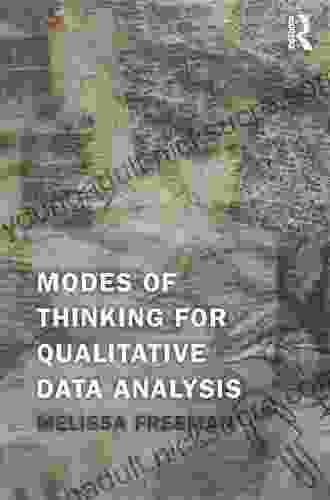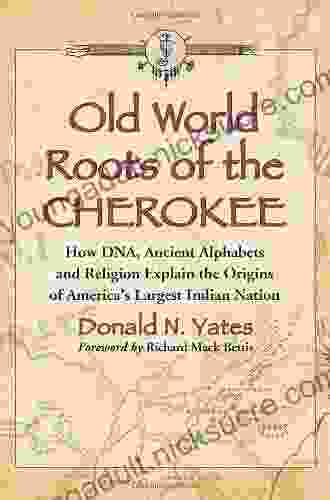How DNA, Ancient Alphabets, and Religion Explain the Origins of America's Largest Mounds

The vast landscapes of North America are dotted with enigmatic earthworks, colossal mounds that have long puzzled archaeologists and historians alike. These towering structures, some stretching hundreds of feet in length and height, stand as silent witnesses to a rich and complex past. Among these enigmatic mounds, none are more awe-inspiring than the largest: Cahokia, located in present-day Illinois.
4.5 out of 5
| Language | : | English |
| File size | : | 9440 KB |
| Text-to-Speech | : | Enabled |
| Screen Reader | : | Supported |
| Enhanced typesetting | : | Enabled |
| Word Wise | : | Enabled |
| Print length | : | 429 pages |
| X-Ray for textbooks | : | Enabled |
Cahokia, a sprawling metropolis that flourished between 1050 and 1350 CE, was once home to an estimated 20,000 to 40,000 people. Its central feature, Monks Mound, is the largest prehistoric earthen structure in the Americas, rising 100 feet in height and covering an area of 14 acres. This monumental mound, along with numerous other earthworks and structures, has attracted the attention of researchers from around the world, eager to unravel the secrets of this ancient civilization.
In recent years, groundbreaking discoveries in DNA analysis, ancient alphabet research, and religious studies have shed new light on the origins of Cahokia and other large mounds in North America. These findings challenge traditional assumptions and provide compelling evidence for the existence of a sophisticated and interconnected ancient civilization, spanning vast distances and leaving an enduring legacy on the continent.
DNA Evidence: A Genetic Link to the Past
DNA analysis of Native American populations has revealed a deep genetic connection between the builders of Cahokia and other mound-building cultures in the eastern United States. Studies have shown that these ancient peoples shared a common ancestry with populations in Central and South America, suggesting a migration from these regions thousands of years ago.
Further research has identified specific genetic markers that are prevalent among Native American populations associated with mound-building traditions. These genetic markers provide evidence for a shared cultural heritage and a possible genetic predisposition for the construction of monumental earthworks.
Ancient Alphabets: Deciphering the Written Past
Alongside DNA evidence, the discovery of ancient alphabets has played a crucial role in understanding the origins of America's largest mounds. Researchers have identified similarities between symbols found on pottery, stone tablets, and other artifacts from Cahokia and ancient writing systems from the Middle East and Europe.
One particularly intriguing connection is to the Proto-Sinaitic script, an early writing system that emerged in the Sinai Peninsula around 1800 BCE. This script is believed to be the precursor to many later alphabetic systems, including the Phoenician, Greek, and Latin alphabets.
Striking similarities have been found between Proto-Sinaitic symbols and symbols found on Cahokia artifacts. This suggests that the ancient people of Cahokia may have had contact with or knowledge of writing systems from distant lands, potentially facilitating the exchange of ideas and technologies.
Religion and Sacred Geometry: Unveiling the Spiritual Significance
Beyond DNA and ancient alphabets, religious beliefs and practices played a profound role in the construction of Cahokia and other large mounds. Archaeological evidence indicates that these structures were often used for religious ceremonies, rituals, and astronomical observations.
The geometric patterns and alignments of the mounds suggest a sophisticated understanding of sacred geometry. The Great Serpent Mound in Ohio, for example, is an effigy mound shaped like a serpent extending over 1,300 feet in length. Its intricate design and alignment with the solstices indicate that it was likely used for religious or ceremonial purposes.
Mound City Group in Ohio and Serpent Mound in Georgia are other examples of large mounds that exhibit sacred geometry and possible astronomical alignments. These structures demonstrate the importance of religion and spirituality in the lives of the ancient mound builders.
The Mississippian Culture: A Legacy of Mound Building
The Mississippian culture, which flourished between 800 and 1500 CE, is widely regarded as the primary civilization responsible for the construction of large mounds in North America. This culture encompassed a vast region stretching from the Gulf Coast to the Great Lakes and included major centers such as Cahokia, Mound City Group, and Spiro Mounds.
The Mississippian people were skilled architects and engineers who developed complex political and social systems. Their mounds served as administrative centers, religious temples, burial grounds, and defensive fortifications. The scale and sophistication of these structures reflect the power and organization of the Mississippian civilization.
Antecedents and Influences: Exploring Earlier Mound-Building Cultures
While the Mississippian culture is closely associated with large-scale mound building, evidence suggests that earlier cultures also engaged in this practice. The Adena culture (1000-200 BCE) and the Hopewell culture (200 BCE-500 CE) constructed smaller mounds and earthworks, laying the foundation for the monumental structures built by the Mississippians.
The Fort Ancient culture (1000-1750 CE) in the Ohio Valley also left behind a legacy of large mounds. Oneota culture (1000-1700 CE) sites in the Upper Midwest feature impressive earthworks, including the Aztalan site in Wisconsin.
: A Multifaceted Legacy
The origins of America's largest mounds are a complex and multifaceted story, involving a convergence of DNA, ancient alphabets, religion, and cultural influences. DNA evidence suggests a genetic connection between mound builders and ancient populations in Central and South America.
The discovery of ancient alphabet symbols on Cahokia artifacts raises intriguing possibilities of long-distance connections and knowledge exchange. Religious beliefs and practices played a central role in the construction and use of mounds, evidenced by their sacred geometry and alignment with celestial events.
The Mississippian culture emerged as the dominant mound-building civilization, leaving behind a legacy of impressive structures that showcased their architectural prowess and societal organization. Earlier cultures, such as the Adena, Hopewell, Fort Ancient, and Oneota, also contributed to the tradition of mound building in North America.
Through continued research and collaboration, we continue to unravel the mysteries surrounding the origins and significance of America's largest mounds. These enigmatic structures stand as a testament to the creativity, ingenuity, and spiritual beliefs of ancient civilizations, leaving a lasting imprint on the landscape and the collective memory of the continent.
4.5 out of 5
| Language | : | English |
| File size | : | 9440 KB |
| Text-to-Speech | : | Enabled |
| Screen Reader | : | Supported |
| Enhanced typesetting | : | Enabled |
| Word Wise | : | Enabled |
| Print length | : | 429 pages |
| X-Ray for textbooks | : | Enabled |
Do you want to contribute by writing guest posts on this blog?
Please contact us and send us a resume of previous articles that you have written.
 Fiction
Fiction Non Fiction
Non Fiction Romance
Romance Mystery
Mystery Thriller
Thriller SciFi
SciFi Fantasy
Fantasy Horror
Horror Biography
Biography Selfhelp
Selfhelp Business
Business History
History Classics
Classics Poetry
Poetry Childrens
Childrens Young Adult
Young Adult Educational
Educational Cooking
Cooking Travel
Travel Lifestyle
Lifestyle Spirituality
Spirituality Health
Health Fitness
Fitness Technology
Technology Science
Science Arts
Arts Crafts
Crafts DIY
DIY Gardening
Gardening Petcare
Petcare Jerry Toner
Jerry Toner Lawrence Goldstone
Lawrence Goldstone Cap N Fatty Goodlander
Cap N Fatty Goodlander Robert Lindsay
Robert Lindsay Oliver Burkeman
Oliver Burkeman Jim Saccomano
Jim Saccomano Ingrid S Clay
Ingrid S Clay Seth Lloyd
Seth Lloyd Louis Martin
Louis Martin Jamie Kuykendall
Jamie Kuykendall Howell Raines
Howell Raines Martin Volken
Martin Volken Irene Gut Opdyke
Irene Gut Opdyke Mandee Heller Adler
Mandee Heller Adler Jeremy Klaff
Jeremy Klaff Daniel Friedmann
Daniel Friedmann Violet White
Violet White Scott Alan Johnston
Scott Alan Johnston David Graeber
David Graeber Troy A Hill
Troy A Hill Rachel Connelly
Rachel Connelly Gary B Meisner
Gary B Meisner Elizabeth Hunter
Elizabeth Hunter David Goodman
David Goodman James M Johnston
James M Johnston William Bryant Logan
William Bryant Logan Afra J Zomorodian
Afra J Zomorodian Eliot Schrefer
Eliot Schrefer Lisa Preston
Lisa Preston Samuel B Green
Samuel B Green Sharon Strand Ellison
Sharon Strand Ellison Wynne Foster
Wynne Foster John B Nici
John B Nici Jason Hogan
Jason Hogan Robert E Stake
Robert E Stake Peter Gibson
Peter Gibson Madison Lee
Madison Lee Shalabh Aggarwal
Shalabh Aggarwal Miles Olson
Miles Olson Rafael Gordillo Naranjo
Rafael Gordillo Naranjo Mtg Editorial Board
Mtg Editorial Board Douglas Henderson Jr
Douglas Henderson Jr Joe Berardi
Joe Berardi Elly Molina
Elly Molina Jane M Healy
Jane M Healy Jennifer Bohnet
Jennifer Bohnet Baby Professor
Baby Professor Julia Reed
Julia Reed Andy Dowsett
Andy Dowsett Devaki Lakshmi
Devaki Lakshmi Chip Heath
Chip Heath Bret A Moore
Bret A Moore Andy Peloquin
Andy Peloquin Diana Winston
Diana Winston Jeffrey T Richelson
Jeffrey T Richelson Lindsay Ford
Lindsay Ford Christopher Nyerges
Christopher Nyerges Chuck Weikert
Chuck Weikert William E Hearn
William E Hearn Ken Dryden
Ken Dryden Keith Elliot Greenberg
Keith Elliot Greenberg Lynn Palm
Lynn Palm Lidia Bastianich
Lidia Bastianich Shreya Ramachandran
Shreya Ramachandran Keylee C Hargis
Keylee C Hargis Tim Thayne
Tim Thayne Charlotte Klaar Phd
Charlotte Klaar Phd Mirabai Starr
Mirabai Starr Israelin Shockness
Israelin Shockness Lois A Ritter
Lois A Ritter Peter Finch
Peter Finch Alex Wolf
Alex Wolf Judith S Beck
Judith S Beck Leonard Lueras
Leonard Lueras Erin Moulton
Erin Moulton Roland A Boucher
Roland A Boucher Ryan Bow
Ryan Bow Viviana Altuve
Viviana Altuve Jonah Lehrer
Jonah Lehrer Erich Fromm
Erich Fromm Jodi Shabazz
Jodi Shabazz Ellen Frank
Ellen Frank Kyle Graves
Kyle Graves Humberto G Garcia
Humberto G Garcia Carlo Rovelli
Carlo Rovelli John Sonmez
John Sonmez Teresa Parker
Teresa Parker Robert Dudley
Robert Dudley George Johnson
George Johnson Mark W Steege
Mark W Steege Fredrik Backman
Fredrik Backman Robert Zubek
Robert Zubek Beth A Leonard
Beth A Leonard Tiara Mcclure
Tiara Mcclure Gerard Siggins
Gerard Siggins Alberta Hawse
Alberta Hawse Diana Nyad
Diana Nyad David C Keehn
David C Keehn Laura Hillman
Laura Hillman Ashley Rickards
Ashley Rickards Mike Chambers
Mike Chambers Jonathan Gottschall
Jonathan Gottschall Jay Griffiths
Jay Griffiths Kenneth R Ginsburg
Kenneth R Ginsburg Johnson Egonmwan
Johnson Egonmwan Elizabeth Foss
Elizabeth Foss Jeanne Godfrey
Jeanne Godfrey Kevin Hunter
Kevin Hunter Gregory J Davenport
Gregory J Davenport Shenila Khoja Moolji
Shenila Khoja Moolji Nicole Smith
Nicole Smith Frederick Aardema
Frederick Aardema Adam Skolnick
Adam Skolnick Rebecca Solnit
Rebecca Solnit John Geiger
John Geiger Nicholas Jubber
Nicholas Jubber Margaret M Quinlan
Margaret M Quinlan Scott Stillman
Scott Stillman Kathryn Miles
Kathryn Miles Joan Jacobs Brumberg
Joan Jacobs Brumberg Derek M Steinbacher
Derek M Steinbacher L S Boos
L S Boos Nathaniel Rich
Nathaniel Rich Ron Douglas
Ron Douglas T R Fehrenbach
T R Fehrenbach Forrest Maready
Forrest Maready Tania N Shah
Tania N Shah Joshua Clark
Joshua Clark Rashaun Johnson
Rashaun Johnson Tovah Feldshuh
Tovah Feldshuh Murtaza Haider
Murtaza Haider Joy Williams
Joy Williams Ben Ehrenreich
Ben Ehrenreich Ben Bleiweiss
Ben Bleiweiss Richard Bate
Richard Bate Tovar Cerulli
Tovar Cerulli Kim Dragoner
Kim Dragoner Florian Freistetter
Florian Freistetter James Quinn
James Quinn Chef Maggie Chow
Chef Maggie Chow Jeffrey Thurston
Jeffrey Thurston Christina Reese
Christina Reese Rick Vaive
Rick Vaive Susan Burton
Susan Burton Germano Dalcielo
Germano Dalcielo Donna Helen Crisp Jd Msn Rn Pmhcns Bc
Donna Helen Crisp Jd Msn Rn Pmhcns Bc Lee Cronk
Lee Cronk Kathy Hoopmann
Kathy Hoopmann Walter Beede
Walter Beede Kim Foley Mackinnon
Kim Foley Mackinnon Howard Davis
Howard Davis Cynthia Nims
Cynthia Nims Richard Lemaster
Richard Lemaster Daddilife Books
Daddilife Books Cheryl Alkon
Cheryl Alkon Harry Fairhead
Harry Fairhead Tom Dymond
Tom Dymond Barry Pickthall
Barry Pickthall Ben Campbell
Ben Campbell Andy Farrell
Andy Farrell Stephen Jungmann
Stephen Jungmann Karl Beecher
Karl Beecher United States Government Us Army
United States Government Us Army Jules Brown
Jules Brown Kathy Freston
Kathy Freston Lisa Marie Mercer
Lisa Marie Mercer Colby Coombs
Colby Coombs Dan Ariely
Dan Ariely Jeffrey Bernstein
Jeffrey Bernstein Andrea Lankford
Andrea Lankford Ruth Benedict
Ruth Benedict Emily Souder
Emily Souder Eric Schmitz
Eric Schmitz Richard Lee Byers
Richard Lee Byers Shane O Mara
Shane O Mara Karen Elliott House
Karen Elliott House Rebecca Eanes
Rebecca Eanes Angelo Lowery
Angelo Lowery Marc Charles
Marc Charles Avinash Navlani
Avinash Navlani J D Swanson
J D Swanson Chris Chelios
Chris Chelios Tim Larkin
Tim Larkin Angela Smith
Angela Smith S L Macgregor Mathers
S L Macgregor Mathers Mark Synnott
Mark Synnott Leanne Ely
Leanne Ely Nick Bradley
Nick Bradley Andy Crowe
Andy Crowe R E Burrillo
R E Burrillo Chris Santella
Chris Santella Thais Nye Derich
Thais Nye Derich Joyce Yang
Joyce Yang Roger Craig
Roger Craig Eugene P Northrop
Eugene P Northrop Gillian Price
Gillian Price Bill Schneider
Bill Schneider Jorge Ramos Mizael
Jorge Ramos Mizael Jessica Jung
Jessica Jung Siena Cherson Siegel
Siena Cherson Siegel Mercedes Pollmeier
Mercedes Pollmeier Kevin Thomas
Kevin Thomas Angelo Tropea
Angelo Tropea Tom Chatfield
Tom Chatfield Margaret Visser
Margaret Visser Rosie Daley
Rosie Daley Rufus Estes
Rufus Estes Bob Gordon
Bob Gordon Rachel Hutt Phd
Rachel Hutt Phd D M Davis
D M Davis Ryan Beck
Ryan Beck Richard L Sites
Richard L Sites Stephen Rea
Stephen Rea Paul Cobley
Paul Cobley Dean Beaumont
Dean Beaumont Michael Anthony
Michael Anthony Scott Turner
Scott Turner Jeff Mach
Jeff Mach Manik Joshi
Manik Joshi Wayne Mcghie
Wayne Mcghie Dhonielle Clayton
Dhonielle Clayton W Todd Woodard
W Todd Woodard Stefan Hunziker
Stefan Hunziker Emma Dalton
Emma Dalton Carol Ann Gillespie
Carol Ann Gillespie Richard G Brown
Richard G Brown Dawn Griffiths
Dawn Griffiths Nikki Ace
Nikki Ace Jim Prime
Jim Prime G K Derosa
G K Derosa Joseph Phillips
Joseph Phillips Donald N Yates
Donald N Yates Catherine Mccord
Catherine Mccord Tristan Higbee
Tristan Higbee Kristen Jervis Cacka
Kristen Jervis Cacka George Noory
George Noory Greg Prato
Greg Prato Rachel Kowert
Rachel Kowert Marie Brennan
Marie Brennan Milton Roth
Milton Roth Robert Urban
Robert Urban Pete Dunne
Pete Dunne Angeline Boulley
Angeline Boulley Patrick Pickens
Patrick Pickens Kari Marie Norgaard
Kari Marie Norgaard Michael V Uschan
Michael V Uschan Emily Nielson
Emily Nielson Richard Hibshman
Richard Hibshman Phil Burt
Phil Burt Yuu Tanaka
Yuu Tanaka Jodi Picoult
Jodi Picoult Danil Zburivsky
Danil Zburivsky Caspar Melville
Caspar Melville Otto Rahn
Otto Rahn Sam Bleakley
Sam Bleakley Dwight E Neuenschwander
Dwight E Neuenschwander George E Hein
George E Hein Robb Manning
Robb Manning Marilyn Burgos
Marilyn Burgos Marie Myung Ok Lee
Marie Myung Ok Lee Donna Mott
Donna Mott Ryan D Agostino
Ryan D Agostino Robin Yocum
Robin Yocum Jessica Wolstenholm
Jessica Wolstenholm Arlin Smith
Arlin Smith Wendy Rosenoff
Wendy Rosenoff Raynor Winn
Raynor Winn William D Lopez
William D Lopez Matthew D Dewar
Matthew D Dewar Hajime Isayama
Hajime Isayama Rebecca Boggs Roberts
Rebecca Boggs Roberts Sandra Steingraber
Sandra Steingraber David E Jones
David E Jones Kate Le Roux
Kate Le Roux Christian Wiggins
Christian Wiggins Barak Ariel
Barak Ariel Sylvester Nemes
Sylvester Nemes Rodney Paul
Rodney Paul Stuart Lawrence
Stuart Lawrence Michael Tomasello
Michael Tomasello Tim Macwelch
Tim Macwelch Serena B Miller
Serena B Miller Angelina J Steffort
Angelina J Steffort Warren St John
Warren St John Robyn Ryle
Robyn Ryle Kent David Kelly
Kent David Kelly Andy Jurinko
Andy Jurinko Jay Matthews
Jay Matthews M J Fievre
M J Fievre Jeffrey Lee
Jeffrey Lee Andy Schell
Andy Schell Neveen Musa
Neveen Musa Ray Walker
Ray Walker Angela Leslee
Angela Leslee Harold S Koplewicz
Harold S Koplewicz Aaron Wilson
Aaron Wilson Jordan Summers
Jordan Summers Sir Edmund Hillary
Sir Edmund Hillary Margaret Jordan Halter
Margaret Jordan Halter Eli Wilson
Eli Wilson Lynn Lyons
Lynn Lyons Alessio Mangoni
Alessio Mangoni Donald R Prothero
Donald R Prothero Stewart Shapiro
Stewart Shapiro Bradley Charbonneau
Bradley Charbonneau Sabbithry Persad Mba
Sabbithry Persad Mba Bernd Heinrich
Bernd Heinrich Tara Sim
Tara Sim Stephen Lynch
Stephen Lynch Anna Rashbrook
Anna Rashbrook Hourly History
Hourly History Linda Sivertsen
Linda Sivertsen Thomas Gilovich
Thomas Gilovich Ruby Lang
Ruby Lang John Samuel Barnett
John Samuel Barnett Steve Hindman
Steve Hindman T L Payne
T L Payne Angela Thayer
Angela Thayer Ted Sandling
Ted Sandling Mark Shepherd
Mark Shepherd Frank Deford
Frank Deford Rawdon Wyatt
Rawdon Wyatt Tanya Lee Stone
Tanya Lee Stone Stephanie Land
Stephanie Land Muako Maepa
Muako Maepa Angel Burns
Angel Burns Tj Faultz
Tj Faultz Kristen S Kurland
Kristen S Kurland Angela Eckhoff
Angela Eckhoff Meg Long
Meg Long Karen Sternheimer
Karen Sternheimer Natalie Rhodes
Natalie Rhodes Rebecca Serle
Rebecca Serle Massimo Florio
Massimo Florio Third Edition Kindle Edition
Third Edition Kindle Edition Matt Vincent
Matt Vincent K Moriyasu
K Moriyasu Robin Ray Green
Robin Ray Green Kim West
Kim West Mark Wells
Mark Wells Angela C Wu
Angela C Wu Lutz Hanseroth
Lutz Hanseroth Bob Swope
Bob Swope Brian Cain
Brian Cain Miranda Green
Miranda Green Kat Anderson
Kat Anderson Michael Driscoll
Michael Driscoll Ed Stafford
Ed Stafford Tina Nelson
Tina Nelson Robin Benway
Robin Benway Kevin J Gaston
Kevin J Gaston Lin Wellford
Lin Wellford Capn Fatty Goodlander
Capn Fatty Goodlander Bob Clouser
Bob Clouser Emiko Jean
Emiko Jean Robyn Wideman
Robyn Wideman Latonya J Trotter
Latonya J Trotter Caryl Say
Caryl Say Mark J Musser
Mark J Musser Stefanie K Johnson
Stefanie K Johnson Janet Menzies
Janet Menzies Sandy Tolan
Sandy Tolan Jenna Helwig
Jenna Helwig Dan Heath
Dan Heath Sam Fury
Sam Fury Tim O Connor
Tim O Connor Stephen Grossberg
Stephen Grossberg Kristina Statler
Kristina Statler Ariel Henley
Ariel Henley Liv Ryan
Liv Ryan Tea Rozman Clark
Tea Rozman Clark Robert Kirk
Robert Kirk Ellen J Langer
Ellen J Langer Joe Peta
Joe Peta Katrina Cope
Katrina Cope Michele Borba
Michele Borba Jessica Nordell
Jessica Nordell Thomas Golf
Thomas Golf Christina Hillsberg
Christina Hillsberg Judea Pearl
Judea Pearl Karl E Peace
Karl E Peace Patrick Ejeke
Patrick Ejeke Rod Powers
Rod Powers Mary Pipher
Mary Pipher Ashley P Martin
Ashley P Martin Mark Kernion
Mark Kernion Keith Crowley
Keith Crowley Angela Stancar Johnson
Angela Stancar Johnson Connie Schultz
Connie Schultz Robyn Harding
Robyn Harding Mark Verstegen
Mark Verstegen Christian Heath
Christian Heath Richard A Muller
Richard A Muller Johnny Molloy
Johnny Molloy Carlos Acevedo
Carlos Acevedo Madeleine Roux
Madeleine Roux Stacy Mccullough
Stacy Mccullough Dr Eva Beaulieu
Dr Eva Beaulieu Dave Duncan
Dave Duncan Jenny Smith
Jenny Smith Jenna Blough
Jenna Blough Kelly Corrigan
Kelly Corrigan Andy Mitchell
Andy Mitchell Yvonne Choquet Bruhat
Yvonne Choquet Bruhat Samir P Desai
Samir P Desai Dennis Rainey
Dennis Rainey Petros Efthymiou
Petros Efthymiou Elizabeth Kaledin
Elizabeth Kaledin Mark Remy
Mark Remy Deborah Wall
Deborah Wall Guy Evans
Guy Evans John C Maxwell
John C Maxwell Bradley T Erford
Bradley T Erford Warren Sande
Warren Sande Nicholas Epley
Nicholas Epley Tim Hannigan
Tim Hannigan Rodney Castleden
Rodney Castleden Scott Meyer
Scott Meyer Rebecca P Cohen
Rebecca P Cohen Schoolhouse Heaven
Schoolhouse Heaven Dave Gray
Dave Gray Dave Smith
Dave Smith Rob Willson
Rob Willson Mark Rosenman
Mark Rosenman Patrick M Lencioni
Patrick M Lencioni Peter Townsend
Peter Townsend Cory Mortensen
Cory Mortensen Tirzah Price
Tirzah Price Charney Herst
Charney Herst Joseph Mazur
Joseph Mazur Mark Lester
Mark Lester David Herres
David Herres Jeff Fleischer
Jeff Fleischer Lucy Postgate
Lucy Postgate Neil Hawkesford
Neil Hawkesford Tigran Bagdasaryan
Tigran Bagdasaryan David Kinney
David Kinney Belinda Norton
Belinda Norton Chanel Craft Tanner
Chanel Craft Tanner Tom Allen
Tom Allen Mometrix
Mometrix George Megre
George Megre Rebecca Hemmings
Rebecca Hemmings Ron Jeffries
Ron Jeffries Joel J Lerner
Joel J Lerner Nicholas D Kristof
Nicholas D Kristof Christopher O Kennon
Christopher O Kennon Laura Bogen
Laura Bogen Angel Millar
Angel Millar Mitch Horowitz
Mitch Horowitz Jim Posewitz
Jim Posewitz Angelo Chiari
Angelo Chiari Cate Tiernan
Cate Tiernan Jo May
Jo May William Ayers
William Ayers Stephen Cheney
Stephen Cheney Jon Ronson
Jon Ronson Andy Puddicombe
Andy Puddicombe Pete Sampras
Pete Sampras Andy Tyson
Andy Tyson Judith Hoare
Judith Hoare
Light bulbAdvertise smarter! Our strategic ad space ensures maximum exposure. Reserve your spot today!

 Warren Bell860 Days: One Step At A Time, A Journey of Overcoming Addiction and Finding...
Warren Bell860 Days: One Step At A Time, A Journey of Overcoming Addiction and Finding...
 Daniel KnightCatching Fish, Throwing Balls, and Flying Kites: Outdoor Activities to Beat...
Daniel KnightCatching Fish, Throwing Balls, and Flying Kites: Outdoor Activities to Beat... Travis FosterFollow ·12.2k
Travis FosterFollow ·12.2k Pablo NerudaFollow ·18.3k
Pablo NerudaFollow ·18.3k Marc FosterFollow ·13.5k
Marc FosterFollow ·13.5k George R.R. MartinFollow ·3.2k
George R.R. MartinFollow ·3.2k Clark BellFollow ·2.3k
Clark BellFollow ·2.3k Joe SimmonsFollow ·7.2k
Joe SimmonsFollow ·7.2k Jesse BellFollow ·2.5k
Jesse BellFollow ·2.5k Dean ButlerFollow ·7k
Dean ButlerFollow ·7k

 Devon Mitchell
Devon MitchellDelve into the Comprehensive World of Cartridges: A...
In the realm of firearms, cartridges stand...

 Joseph Conrad
Joseph ConradTales From The San Francisco 49ers Sideline: A Look...
The San Francisco 49ers are one of the most...

 Ervin Bell
Ervin BellArcGIS Desktop 10: A Comprehensive GIS Tutorial for...
Geographic information...

 Reed Mitchell
Reed MitchellPhysiology Pretest Self Assessment And Review 14th...
Accurately gauge your physiology knowledge and...

 Devin Ross
Devin RossLost At Sea: The Unbelievable True Story of the Jon...
In 2009, journalist Jon Ronson set out to...

 Shane Blair
Shane BlairModes of Thinking for Qualitative Data Analysis
Qualitative data analysis is a complex...
4.5 out of 5
| Language | : | English |
| File size | : | 9440 KB |
| Text-to-Speech | : | Enabled |
| Screen Reader | : | Supported |
| Enhanced typesetting | : | Enabled |
| Word Wise | : | Enabled |
| Print length | : | 429 pages |
| X-Ray for textbooks | : | Enabled |








